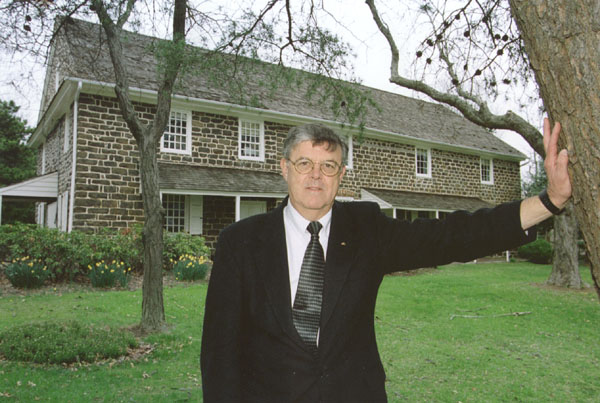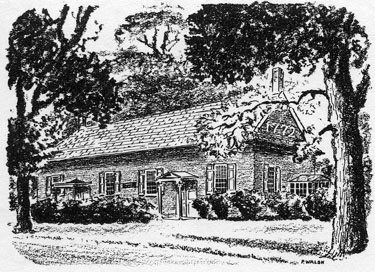
QUAKER MEETING HOUSES
of BURLINGTON COUNTY, NEW JERSEY
by Joe Laufer


Joe Laufer in front of Mount Laurel Quaker Meeting House
The Quaker influence on the origins, colonization and development of Burlington County go back to the arrival from England of the Kent at Burlington City in 1677 and the Shield in 1678 and the involvement of William Penn in the establishing of West Jersey in 1680. The philosophy upon which Burlington County was formed was derived from the Concessions and Agreements of 1677. The Concessions, written by William Penn (1644-1718) and other Quakers, guaranteed representative government, fair treatment of Native Americans and civil rights and protection for all inhabitants.
Even before the arrival of the Kent and Shield, the Quakers had a stake in Burlington County. George Fox himself (the founder of the Society of Friends) had crossed and recrossed New Jersey during his religious vist to America in 1672. In fact, there is a record of Fox being in the Burlington City area on July 12, 1672.
Later, William Penn was chosen by Fox to arbitrate a dispute between John Fenwick and Edward Byllynge over land in West Jersey in 1674 (Penn was 30 years old). "The purchase of 1674 is an event of the greatest historical significance for it marks the beginning of the first great Quaker experiment in American Colonization" says Edwin P. Tanner. As a result of his involvement, Penn helped establish the Province of West Jersey in 1680. Subsequently, in 1681, East Jersey was purchased.
The Quaker colonists went right to work to establish schools, meeting houses and cemeteries throughout Burlington County, starting first in Burlington City. By 1681 there were 1,400 Quakers in Burlington County. Records show that in 1699 the "Friends" were more numerous in Burlington County than all other counties in the Delaware Valley.
Today there are 20 Quaker Meeting Houses in Burlington County -- some active, and some "laid down" (the Quaker term for being abandoned and turned over for other uses). Joe Laufer has visited all the sites and photographed them to put together an illustrated lecture dealing with the history and architecture of these historic buildings. Some communities have two meeting houses, as a result of the "Hicksite Separation" in 1827 -- a reform movement which created a splinter group which separated "Orthodox" from "Hicksite" believers. Fortunately, in 1952, the 300th Anniversary of the founding of Quakerism by George Fox in England, there was a reunification of all Quakers into one body of believers.
Recently, Joe served as the historical advisor to the Burlington County Times for a series of articles on the Quaker Meeting Houses. The final article in the series consisted of a self-guided driving tour of Burlington County's Quaker Meeting Houses. The guide is posted on www.BurlcoHistorian.com, the County Historian's web site ("Local History" tab). You may click here for a direct link to the tour.
Listed below are the 20 Quaker Meeting Houses in Burlington County, New Jersey, in the order of their founding:
1. Burlington - 1687
Located on High Street, Burlington.
Now a regional conference center for Southeastern Pennsylvania/New Jersey Quakers operated by the Philadelphia Yearly Meeting. Of historical significance, the first meetinghouse on this site was a hexagonal frame structure built in the 1600s. In the Burial
Click here for photo (1784 building)
Click here for old b/w photo
2. Crosswicks - 1693
Located on Front and Church Streets in heart of Crosswicks Village.
Active Meeting House. Of historic interest, has a connon ball imbeded in one wall, a result of a Revolutionary War battle.
Click here for photo (1773 building)
3. Moorestown - 1700
4. Rancocas - 1703

Located on the north side of Main Street in the Village of Rancocas in Westhampton, just off Beverly-Rancocas Road.
Active Meeting House
Click here for photo (1772 building)
Click here for old b/w photo
5. Mount Holly - 1716
Loctaed at 81 High Street at the corner of Garden St., Mount Holly.
Active Meeting House. Recently restored with the help of a major Historical Preservation grant.
Click here for photo (1775 building)
Click here for old B/W photo of 1775 building
6. Mount Laurel - 1717
Located on Moorestown-Mt. Laurel Road (Rt.603) at intersection of Hainesport-Mt. Laurel Road (Rt. 674).
Seasonally Active Meeting House (May through September) associated with Moorestown Friends Meeting.
Click here for photo (1760e and 1798w)
7. Upper Springfield - 1727
8. Mansfield - 1731
Located on Route 206, near Mt. Pleasant Road, outside the village of Columbus (geographically located on New York Avenue, off Rt. 206).
Not active, except for special events, such as weddings.
Click here for photo of 1812 building
9. Bordentown - 1740
Located at 302 Farnsworth Avenue.
Operated as a museum by Bordentown Historical Society. Recently restored.
Click here for photo of 1740 building.
10. Arney's Mount - 1743
Located on Pemberton-Arney's Mt. Road (668) at intersection of Juliustown Road.
Seasonally Active Meeting House. Recently included in National Park Service's Historic American Buildings Survey (HABS).
Click here for current photo of 1775 building
Click here for old B/W photo of 1775 building
11. Evesham/Marlton (Cropwell) - 1762
12. Lower Springfield (Copany) - 1775
Located on Jacksonville-Jobestown Road at Petticoat Bridge Road.
Now a Private Home. Historical significance as Hessian Hospital during Revolutionary War battle of Petticoat Bridge on Christmas, 1776.
Click here for photo of 1775 building
Click here for old b/w photo
13. Vincentown - 1781
14. Medford (Union Street) - 1793
15. Cinnaminson (Westfield) -1800
16. Crosswicks (Orthodox) - 1831
Located on Ward Avenue in the Crosswicks section of Chesterfield.
Now serves as headquarters for Chesterfield Township Historical Society.
Click here for photo of 1834 building
17. Moorestown (Orthodox) - 1839
Located on grounds of Moorestown Friends School at intersection of Main Street and Chester Avenue, across driveway from 1802 active Meeting House.
Now serves as Cafeteria for Moorestown Friends School.
Click here for photo of 1897 building
Click here for old b/w photo of previous Orthodox Meeting
18. Medford - (Main St.) - 1842
Located on Main Street at southern tip of Village of Medford.
Vacant building. Proposed by developer as potential office complex.
Click here for photo of 1842 building
Since I began my research and picture-taking, I have been advised of two other Burlington County Meeting Houses:
19. Mt. Laurel - 1811 - Easton Meeting House
20. Mt. Laurel - 1813 - Colemantown Meeting House
Located on Elbo Lane, near Moorestown-Mt. Laurel Road.
Currently a part of the Jacobs Chapel (1859) complex of the A.M.E. Church. Historically significant as a stop on the Underground Railroad during the Civil War period. Dr. James Still, the renowned "Black Doctor of the Pines" is buried in the cemetary to the rear of the chapel. The Colemantown Meeting House was moved across the street in 1965.
Click here for 2004 color photo of Jacob's Chapel.
Click here for b/w photo of current Jacob's Chapel.
Note: Dates vary between the establishment of a "meeting" or congregation (which may have met in private homes) or the building of the first Meeting House (which may have primarily been the school) or the building of the first actual place of worship. In several cases, the current meeting house is the third generation of Meeting Houses built on the same site, replacing those destroyed by fire in an earlier age.

SOME RELATED LINKS:
The Historic American Building's Survey (known as the HAB survey), a project of the National Park Service, researched the architecture of Quaker Meeting Houses of the Philadelphia Yearly Meeting in 1999. Among the two New Jersey Quaker Meeting Houses used in the study is the Arney's Mount Meeting House (near Pemberton, in Burlington County):
Historic American Buildings Survey
A site with pictures of Delaware Valley Meeting Houses taken by Norman R. Zelley in 1931. Includes Rancocas (2), Mt. Holly, Burlington, Cropwell, Medford, and Moorestown (2)of typical Quaker Meeting Houses:
Delaware Valley Quaker Meeting Houses in 1931
A Bibliography of works associated with Quaker Meeting Houses:
Quaker History: Meeting Houses - Architecture
A publication dealing with Quaker Meeting Houses:
"Connections": Friends Meeting Houses

Back








